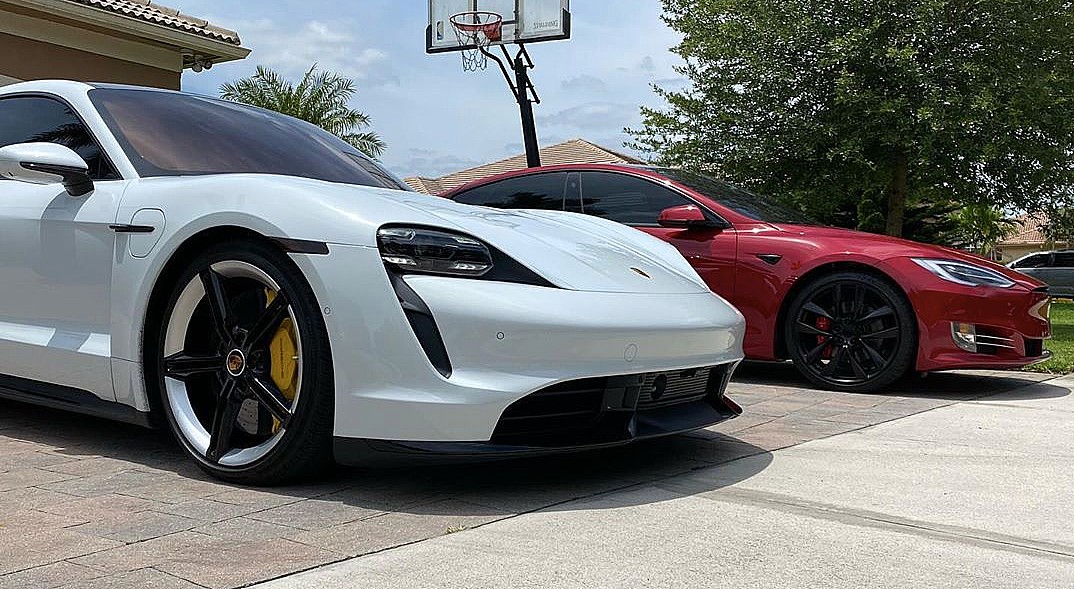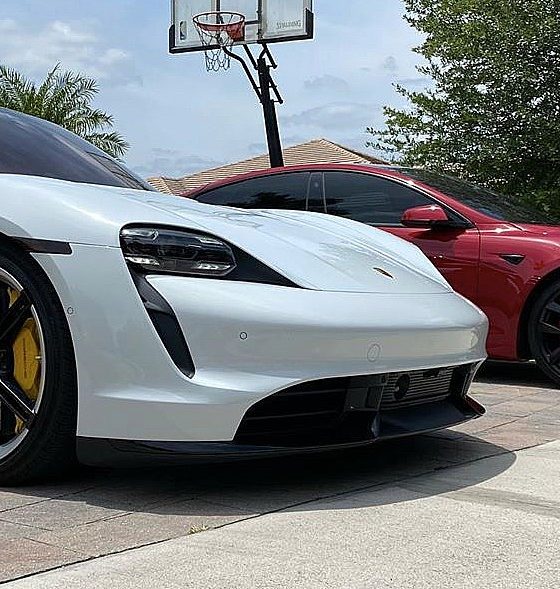

News
Tesla Model S vs Porsche Taycan Turbo S real road race proves mainstream tests were a joke
The Tesla Model S Performance and the Porsche Taycan Turbo S may not exactly belong to the same segment, but both flagship EVs are bound to be considered as rivals thanks to their equally-impressive specs. Unfortunately, real-world races featuring the two vehicles are incredibly rare, and results from previous mainstream tests have proven questionable.
On paper, the Tesla Model S Performance and the Porsche Taycan Turbo S’s acceleration and top speed are comparable. The Tesla holds an edge in range and tech, and it costs just over half of the Porsche, but the Taycan leads the Model S in classic build quality and track performance. In a lot of ways, races between the two vehicles should be nail-biting rounds, but so far, this has not been the case.
The Tesla Model S Performance and Porsche Taycan Turbo S have been raced against each other by mainstream motoring outlets in the past, such as Top Gear and Car and Driver. However, in both cases, the results of the races have been very strange. In Top Gear’s case, for example, the Taycan dominated, but videos of the race showed that the Model S was in Range Mode and launch control was not enabled. The publication also admitted to using old Model S results from a previous test against a Mercedes-AMG E63S.
Car and Driver’s race results were also a bit strange. The Taycan also soundly beat the Model S, but the publication stated that the Tesla’s 0-60 mph dropped to over 4.0 seconds by the third consecutive race. This was an observation that was contested strongly by some owners of the flagship sedan, several of whom have raced their vehicles consecutively. Fortunately for the electric car community, a real race between the two vehicles has finally been shared online, thanks to the efforts of veteran drag racer Brooks Weisblat of YouTube’s DragTimes.
In a recent video, the DragTimes host was able to get his hands on both a Tesla Model S Raven Performance with the latest Cheetah Stance update, as well as a $206,000 Porsche Taycan Turbo S. The two vehicles could not be tested on an actual drag strip due to the ongoing pandemic, but the two flagship EVs were able to lock horns in a series of road races nonetheless.
The races between the two vehicles played out precisely as their specs would suggest. In the first round, the Taycan got the jump on the launch, and it beat the Model S. The second race went to the Tesla, with the Model S Performance pulling hard enough to snatch the win. Two rolling races followed, and the results were pretty much the same. Overall, two things became very evident. One, the Porsche Taycan definitely holds an advantage in higher speeds thanks to its two-speed gearbox, and two, the Tesla Model S Performance is not a car that could be toyed around by the German-made EV.
Ultimately, Weisblat noted that the results of a real Tesla Model S Performance vs. Porsche Taycan Turbo S drag race would likely depend on the capabilities and reaction times of the two vehicles’ drivers. Both cars are insanely quick, and both are definitely at the top of their class. Ultimately, the Tesla Model S Performance and the Porsche Taycan Turbo S’ rivalry may just be beginning, considering the upcoming release of the Plaid Model S, which will be capable of track driving.

News
Tesla FSD fleet is nearing 7 billion total miles, including 2.5 billion city miles
As can be seen on Tesla’s official FSD webpage, vehicles equipped with the system have now navigated over 6.99 billion miles.

Tesla’s Full Self-Driving (Supervised) fleet is closing in on almost 7 billion total miles driven, as per data posted by the company on its official FSD webpage.
These figures hint at the massive scale of data fueling Tesla’s rapid FSD improvements, which have been quite notable as of late.
FSD mileage milestones
As can be seen on Tesla’s official FSD webpage, vehicles equipped with the system have now navigated over 6.99 billion miles. Tesla owner and avid FSD tester Whole Mars Catalog also shared a screenshot indicating that from the nearly 7 billion miles traveled by the FSD fleet, more than 2.5 billion miles were driven inside cities.
City miles are particularly valuable for complex urban scenarios like unprotected turns, pedestrian interactions, and traffic lights. This is also the difference-maker for FSD, as only complex solutions, such as Waymo’s self-driving taxis, operate similarly on inner-city streets. And even then, incidents such as the San Francisco blackouts have proven challenging for sensor-rich vehicles like Waymos.
Tesla’s data edge
Tesla has a number of advantages in the autonomous vehicle sector, one of which is the size of its fleet and the number of vehicles training FSD on real-world roads. Tesla’s nearly 7 billion FSD miles then allow the company to roll out updates that make its vehicles behave like they are being driven by experienced drivers, even if they are operating on their own.
So notable are Tesla’s improvements to FSD that NVIDIA Director of Robotics Jim Fan, after experiencing FSD v14, noted that the system is the first AI that passes what he described as a “Physical Turing Test.”
“Despite knowing exactly how robot learning works, I still find it magical watching the steering wheel turn by itself. First it feels surreal, next it becomes routine. Then, like the smartphone, taking it away actively hurts. This is how humanity gets rewired and glued to god-like technologies,” Fan wrote in a post on X.
News
Tesla starts showing how FSD will change lives in Europe
Local officials tested the system on narrow country roads and were impressed by FSD’s smooth, human-like driving, with some calling the service a game-changer for everyday life in areas that are far from urban centers.

Tesla has launched Europe’s first public shuttle service using Full Self-Driving (Supervised) in the rural Eifelkreis Bitburg-Prüm region of Germany, demonstrating how the technology can restore independence and mobility for people who struggle with limited transport options.
Local officials tested the system on narrow country roads and were impressed by FSD’s smooth, human-like driving, with some calling the service a game-changer for everyday life in areas that are far from urban centers.
Officials see real impact on rural residents
Arzfeld Mayor Johannes Kuhl and District Administrator Andreas Kruppert personally tested the Tesla shuttle service. This allowed them to see just how well FSD navigated winding lanes and rural roads confidently. Kruppert said, “Autonomous driving sounds like science fiction to many, but we simply see here that it works totally well in rural regions too.” Kuhl, for his part, also noted that FSD “feels like a very experienced driver.”
The pilot complements the area’s “Citizen Bus” program, which provides on-demand rides for elderly residents who can no longer drive themselves. Tesla Europe shared a video of a demonstration of the service, highlighting how FSD gives people their freedom back, even in places where public transport is not as prevalent.
What the Ministry for Economic Affairs and Transport says
Rhineland-Palatinate’s Minister Daniela Schmitt supported the project, praising the collaboration that made this “first of its kind in Europe” possible. As per the ministry, the rural rollout for the service shows FSD’s potential beyond major cities, and it delivers tangible benefits like grocery runs, doctor visits, and social connections for isolated residents.
“Reliable and flexible mobility is especially vital in rural areas. With the launch of a shuttle service using self-driving vehicles (FSD supervised) by Tesla in the Eifelkreis Bitburg-Prüm, an innovative pilot project is now getting underway that complements local community bus services. It is the first project of its kind in Europe.
“The result is a real gain for rural mobility: greater accessibility, more flexibility and tangible benefits for everyday life. A strong signal for innovation, cooperation and future-oriented mobility beyond urban centers,” the ministry wrote in a LinkedIn post.
News
Tesla China quietly posts Robotaxi-related job listing
Tesla China is currently seeking a Low Voltage Electrical Engineer to work on circuit board design for the company’s autonomous vehicles.

Tesla has posted a new job listing in Shanghai explicitly tied to its Robotaxi program, fueling speculation that the company is preparing to launch its dedicated autonomous ride-hailing service in China.
As noted in the listing, Tesla China is currently seeking a Low Voltage Electrical Engineer to work on circuit board design for the company’s autonomous vehicles.
Robotaxi-specific role
The listing, which was shared on social media platform X by industry watcher @tslaming, suggested that Tesla China is looking to fill the role urgently. The job listing itself specifically mentions that the person hired for the role will be working on the Low Voltage Hardware team, which would design the circuit boards that would serve as the nervous system of the Robotaxi.
Key tasks for the role, as indicated in the job listing, include collaboration with PCB layout, firmware, mechanical, program management, and validation teams, among other responsibilities. The role is based in Shanghai.
China Robotaxi launch
China represents a massive potential market for robotaxis, with its dense urban centers and supportive policies in select cities. Tesla has limited permission to roll out FSD in the country, though despite this, its vehicles have been hailed as among the best in the market when it comes to autonomous features. So far, at least, it appears that China supports Tesla’s FSD and Robotaxi rollout.
This was hinted at in November, when Tesla brought the Cybercab to the 8th China International Import Expo (CIIE) in Shanghai, marking the first time that the autonomous two-seater was brought to the Asia-Pacific region. The vehicle, despite not having a release date in China, received a significant amount of interest among the event’s attendees.








